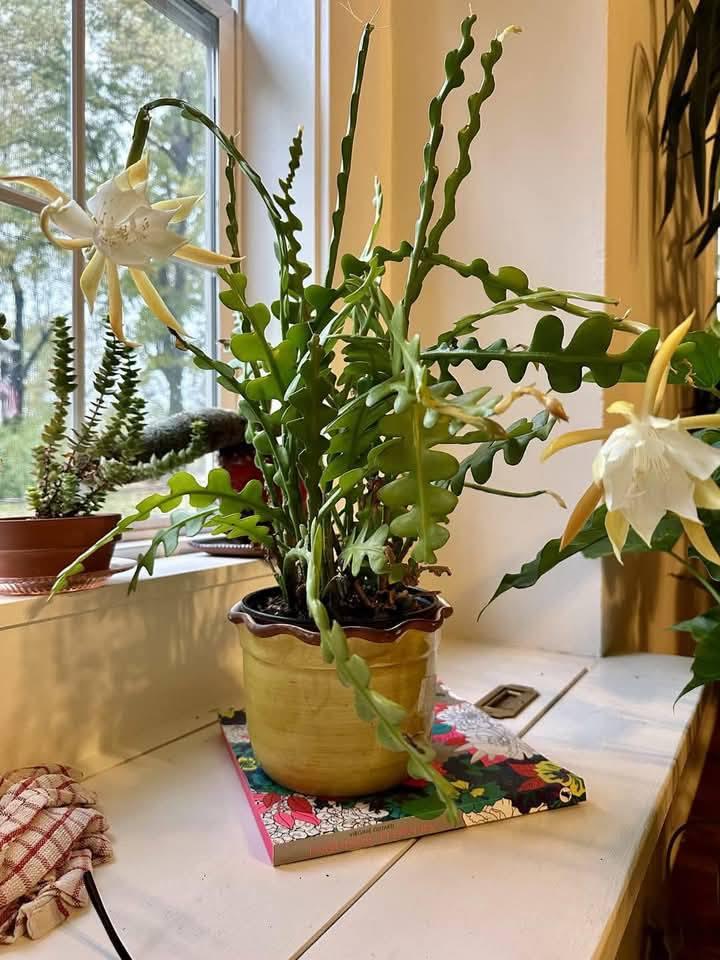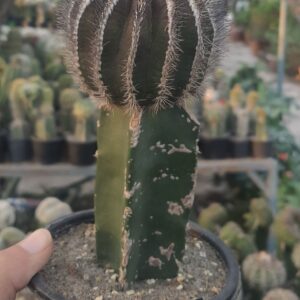Fishbone Cactus “The Unusual Tropical Epiphyte: Fishbone Cactus (Epiphyllum anguliger)
The Fishbone Cactus, also known as Epiphyllum anguliger, is a beautiful and intriguing cactus that differs from the majority of desert cacti. This species is an epiphytic cactus native to the rainforests of Mexico. Like orchids and ferns, it grows on trees rather than in the ground.
The plant is well-known for its zig-zag, serrated stems that look like fish bones, which is why it’s also known as Fishbone Cactus, Ric Rac Cactus, or Zigzag Cactus. It is a highly sought-after houseplant or hanging basket specimen due to its unique appearance, simplicity of upkeep, and sporadic night-blooming flowers.
Overview of the Plants
Epiphyllum anguliger is the scientific name.
Common Names: Zigzag Cactus, Ric Rac Cactus, Fishbone Cactus
Family: Cactaceae
Mexico (tropical rainforests) is where it originated.
Growth Pattern: Trailing, climbing, or hanging
size:
Stems reach a length of 30 to 60 cm (12 to 24 inches).
Capable of spreading far when ripe
USDA Hardiness Zones: 10–11
🌸 Flowers
Late summer to autumn is the time of bloom.
Flowers:
Usually white or pale yellow, large, and aromatic
Blooming at night and continuing through the morning, hence the name.
Extremely gorgeous and bell-shaped
Although indoor blooms are uncommon, mature plants can produce a spectacular nighttime display if the conditions are correct.
☀️ Requirements for Light
Inside:
Favors brilliant, indirect lighting
Avoid direct, intense afternoon sunshine, which can burn the stalks, but tolerate a bit of morning sun.
Ideally situated close to a window facing east or north.
Outside:
It thrives in dappled shade or filtered light, which replicates its native rainforest environment.
Yellowing or sunburn can be caused by too much direct sunlight, whereas insufficient light can result in stunted or elongated growth.
Humidity and temperature
Temperature:
Grows well in temperatures between 18 and 27 degrees Celsius (65 and 80 degrees Fahrenheit).
Should not be exposed to temperatures below 10°C (50°F).
It can thrive outside all year long in tropical or subtropical climates.
Humidity:
Prefers moderate to high humidity
A close humidifier or occasional misting can be helpful, particularly in dry indoor spaces.
Maintaining good air circulation is essential for avoiding fungal issues.
💧 Watering Schedule
Active Growing Season (Spring to Early Fall):
If the top two or three inches of soil feels dry, water it well.
Frequency: Every 7–10 days, but vary depending on the surroundings
Since the roots are vulnerable to rot, prevent waterlogging.
Winter Dormancy:
Water less often—roughly once every three to four weeks.
The soil should be somewhat damp but not damp.
💧 To avoid excessive water retention, always use pots with drainage holes.
Planting Needs for Soil
Kind:
Needs a soil combination that is aerated and has good drainage
The perfect combination consists of:
50% succulent or cactus soil
Coconut coir or orchid bark makes up 25%.
25% pumice or perlite
pH: Mildly acidic to neutral (5.5–7.0)
The airy combination mimics its normal epiphytic growth environment, allowing roots to breathe.
🌾 Manuring
The Season for Growth:
Use a well-balanced, water-soluble fertilizer (like 10-10-10 or a cactus fertilizer) every four weeks.
A liquid fertilizer diluted to half strength works just as well.
Winter:
Refrain from fertilizing during dormancy.
Refrain from overfeeding, as excessive fertilizer might result in weak, excessive growth with fewer blooms.
✂️ Pruning and upkeep
Pruning:
To manage the form and promote more growth, prune.
Take out any stems that are leggy, broken, or dead.
Pruning can encourage branching, resulting in a fuller plant.
Insects:
Vulnerable to:
mealybugs
Spider mites
Scale
Use insecticidal soap or neem oil to treat infestations.
Check the stem undersides and gaps where pests hide frequently.
🌿 Reproduction
Through Stem Cuttings:
Grab stem pieces that are 2–4 inches (5–10 cm) long.
Let the clippings callous for 1–2 days.
Place in a cactus mix that is moderately damp.
In two to four weeks, roots begin to grow.
It is simple to propagate new plants, which guarantees their rapid development.
Use in landscaping and ornamentation
Indoors:
Beautiful in hanging baskets
Works well in macramé plant holders or on shelves.
Works well with trailing plants like String of Pearls or Hoya.
Outside:
Perfect for tropical regions’ greenhouses and shaded patios
It can be trained on trellises or allowed to cascade freely.
✅ Conclusion
The Fishbone Cactus (Epiphyllum anguliger) is a low-maintenance, visually striking houseplant ideal for enhancing the individuality of indoor gardens. It’s a worthwhile complement to any plant enthusiast’s collection because of its unique zigzag stems, fragrant flowers that bloom at night, and simple propagation.
This cactus thrives and may flourish for many years if given the correct balance of indirect light, moderate watering, well-draining soil, and regular feeding.”
fishbone cactus
₨799.00
“The epiphytic cactus known as the Fishbone Cactus (*Disocactus anguliger*), Ric Rac Cactus, or Zig-Zag Cactus is native to the rainforests of Mexico. Because of its distinctive form, flat, and deeply lobed stems that resemble a fishbone or zig-zag pattern, it is a remarkable decorative plant.
This cactus prefers well-draining, moderately moist soil, akin to orchid or cactus mixes, and bright, indirect sunlight. The plant likes moderate watering, with a little drying between waterings. It produces gorgeous, fragrant, night-blooming blossoms in colors of white, yellow, or pink under the correct circumstances.
With little upkeep, the **fishbone cactus** provides a tropical, unusual appearance when planted in hanging baskets or trailed over pots.”





Reviews
There are no reviews yet.